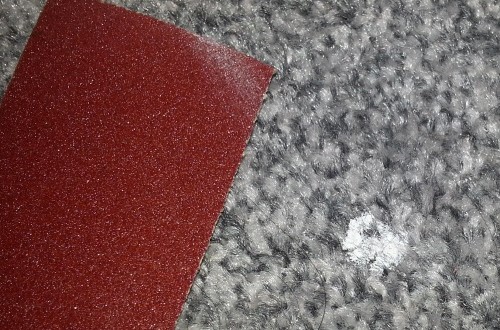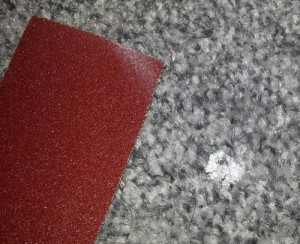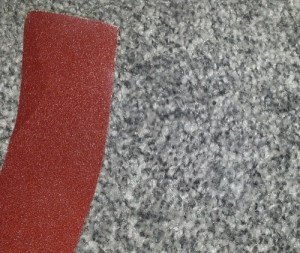After spending literally years doing up our tumble-down old house we are finally getting to the point where we are laying carpet and putting the last coats of paint on some rooms. Like a complete DIY noob’ though I managed to get a spot of paint on one of our new carpets and here’s how I removed it.
First I should probably fess up as to how it happened. It seems that while I was undercoating the window frame I dripped a spot of paint on the floor. I then stood in the drip and proceeded to walk it all over the place. It seems most of it came off in this one spot on the carpet though so I’m not cleaning up the whole house, the downside is that it’s a lot of paint in one place and it’s been trodden in. How you go about removing paint from the carpet depends on the type of paint and when you spot the problem.
Removing Paint from the Carpet – Water Based Emulsion Paints
If you drip emulsion (water based paint for walls and ceilings) on the carpet and spot it while it’s still wet wipe it up immediately with water and rags. Since emulsion paints are water based they dissolve really well in water so the wet rags can generally remove the paint completely. In fact most emulsions are also somewhat soluble even when they have nearly dried or dried completely (kitchen and bathroom paints being an exception) so it’s worth having a go with water before tying anything more aggressive. A word of caution though, don’t overly wet the carpet or you run the risk of having it go moldy. If you have a wet and dry vacuum cleaner use it after you have got the paint up otherwise use tissue to dab as much of the water up as possible. Make sure you don’t rub the carpet too hard or you may create a patch with a different colour to the rest of the carpet.
If the emulsion is completely dry and won’t dissolve in water at all see the technique for removing oil based paints.
Removing Paint from the Carpet – Oil Based Paints
Most importantly do what ever you can to stop oil based paints getting on the carpet in the first place. They can be very difficult to get off and because oil has a lower surface tension than water so it tends to flow down the fibre and coat it much more thoroughly. It’s much easier to prevent the accident than spend time removing paint from the carpet.
Lets say the worst has happened though and you’ve trodden an oil based undercoat into your brand new carpet (who would do something as silly as that?), here’s how you get it up.
Start by doing nothing. Yes, wait for the paint to dry completely without touching it. If you try to get this paint up with water you’ll create an awful sticky mess. If you use thinners of some kind (e.g. white spirit) you will dissolve the paint but you also risk altering the colour of the carpet, dissolving the carpet, dissolving the underlay and burning your house down. Honestly, the best thing you can do is not touch it.
Once the paint has completely dried get a small piece of brand new sand paper. I’m using some 80 grit paper here which I know works well, any aggressive grit (40, 60, 80 even 120) would work though.
Now get down on your hands an knees and assess the problem. The pile on a carpet will tend to lean more in one direction than another, you want to try to work with the pile at least initially. Also look for blobs of paint and carefully check they are dry. If any blobs are dry try to break them up a bit with your finger nail nails or tweezers as it’ll make the job faster. Finally, try to figure out which way the pile twists if it is a twisted pile.
Now you’ve assessed the problem gently stroke the blob of paint with the sand paper in the direction of the pile. Try to avoid rubbing any other bits of the carpet as you don’t want to thin the carpet around the paint. You should see an improvement almost straight away, keep gently rubbing until the rate of improvement drops.
You’ll probably now find that you have paint on the back of the fibres (e.g. the side that is down on the natural lay of the carpet). This is harder to tackle but possible with care. Use a finger nail to bend the fibres against the direction they normally lay and then stroke then with the sand paper. A few strokes should remove most of the paint.
Now push the fibres back and rough up the carpet with your fingers to give it a more normal walked on appearance. Can you see where the paint spot was? If you can still see the paint spot rub the paper gently over the spot in a circular motion going with the twist of the pile if possible.
You’ll find a few fibres will break loose while you are removing the paint, be careful to minimize this and stop if you can see the carpet going bald – the last thing you want to do is replace a paint spot with a bald spot. If you are careful you can achieve the level of paint removal shown above.


